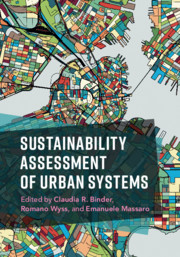Book contents
- Sustainability Assessment of Urban Systems
- Sustainability Assessment of Urban Systems
- Copyright page
- Contents
- Preface
- Acknowledgments
- Contributors
- General Introduction
- Part I Theoretical Background
- Part II Integrative Approaches for Sustainability Assessment
- Part III Perspectives on Urban Sustainability
- Part IV Focal Points of Urban Sustainability
- 15 Energy Challenges in Urban Systems
- 16 Sustainability Assessment of the Housing System: Exploring the Interplay between the Material and Social Systems
- 17 Sustainability Assessment of Urban Agriculture
- 18 Cities and Entropy: Assessing Urban Sustainability as a Problem of Coordination
- 19 Conceptualizing Urban Systems for Ecologic Sustainability Assessments: Case Study of the Stockholm Royal Seaport City District
- 20 A Study of Ride-Sharing Opportunities in the City of Santiago de Chile
- 21 Mosquito-Borne Disease and Human Mobility in Urban Environments
- Index
- References
17 - Sustainability Assessment of Urban Agriculture
from Part IV - Focal Points of Urban Sustainability
Published online by Cambridge University Press: 27 March 2020
- Sustainability Assessment of Urban Systems
- Sustainability Assessment of Urban Systems
- Copyright page
- Contents
- Preface
- Acknowledgments
- Contributors
- General Introduction
- Part I Theoretical Background
- Part II Integrative Approaches for Sustainability Assessment
- Part III Perspectives on Urban Sustainability
- Part IV Focal Points of Urban Sustainability
- 15 Energy Challenges in Urban Systems
- 16 Sustainability Assessment of the Housing System: Exploring the Interplay between the Material and Social Systems
- 17 Sustainability Assessment of Urban Agriculture
- 18 Cities and Entropy: Assessing Urban Sustainability as a Problem of Coordination
- 19 Conceptualizing Urban Systems for Ecologic Sustainability Assessments: Case Study of the Stockholm Royal Seaport City District
- 20 A Study of Ride-Sharing Opportunities in the City of Santiago de Chile
- 21 Mosquito-Borne Disease and Human Mobility in Urban Environments
- Index
- References
Summary
This chapter engages with existing literature and case studies to examine current challenges and ways forward for the sustainability assessment of urban agriculture. It identifies current conceptualisations of urban agriculture, and sustainability assessment methods, and discusses them in the light of normative, systemic, and procedural dimensions of sustainability assessment. The diversity of urban agriculture and its presence in different urban contexts worldwide, represent challenges for sustainability assessment. This chapter shows that there is a paucity of assessment methods that are both specifically developed for urban agriculture and flexible enough to be applicable for different forms of urban agriculture in the Global North and South. Sustainability assessment of agriculture has usually focused on agriculture for market production in relatively stable rural contexts. However, urban agriculture poses challenges of diversity, multi-functionality, contested framings, and knowledge integration, which manifest more acutely in urban than in rural contexts, and which many existing sustainability assessment approaches and methods fail to address. The chapter discusses opportunities to move the practice of sustainability assessment of urban agriculture forward. These include the adoption of inter- and transdisciplinary research strategies, and a critical and reflexive approach to urban agriculture practices, power relations, social norms, and institutional conditions.
Keywords
- Type
- Chapter
- Information
- Sustainability Assessment of Urban Systems , pp. 417 - 437Publisher: Cambridge University PressPrint publication year: 2020



